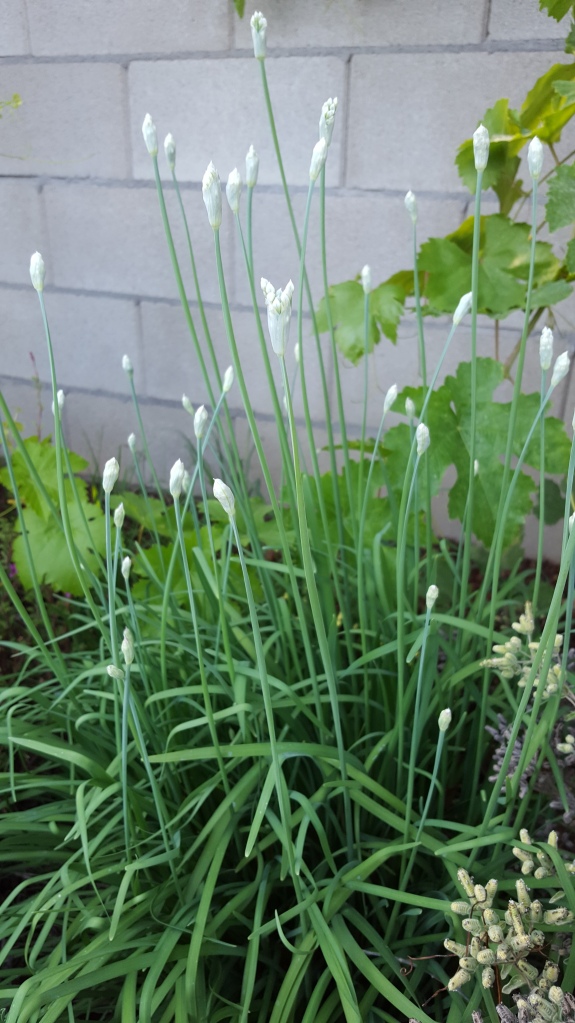
If a recipe calls for 1-2 cloves of garlic, I will automatically add three or four (or five, maybe 6). Because garlic. Garlic chives provide another way to enjoy that awesome garlic flavor with a plant that also offers beauty along with function.
(All links open a new page, so you won’t lose your spot when you look around! Get information on gardening and cultural traditions, recipes, stories, and more!)
A handy growing summary chart is at the end of the article.

Though garlic chives are not actually garlic, they are still a member of the allium family. This group of flavorful plants includes garlic, onions, chives, shallots, leeks, and scallions (also known as green onions), just to name a few. All share that distinctive flavor that adds so much character to a wide variety of dishes.
Of course, one can’t talk about any of the alliums without mentioning their health benefits. Many of the same compounds found in garlic and onions that are responsible for good health are found in other alliums, as well. Things like reduced cholesterol, lowered risks of certain types of cancer, and overall improved cardiovascular health are some of the benefits attributed to diets that regularly include this group of vegetables.

Garlic chives are not likely to be found in the typical grocery store’s produce section, but thankfully seeds are readily available at nurseries or online. Sometimes, potted plants may also be found. They are easy to grow from seed, but be patient as germination may take a couple of weeks or more depending on conditions. It is best to start them when temperatures are still cool, but after the danger of heavy frost has passed. Seeds should be buried only 1/4 inch deep and the soil should be kept evenly moist until you start to see little spears of grass-like leaves emerging. They can be direct-sown in the ground, or in pots indoors. Be sure to gently acclimate them to outside conditions before transplanting.
Garlic chives are drought tolerant once established and can handle a wide range of temperatures from very cold winters to hot summers. They can also grow well in shady areas, especially with high heat conditions, though they will appreciate some direct sun for part of the day.

Unlike chives and onions, the leaves of garlic chives are flattened and not tubular in shape. In fact, they are similar to garlic. These long leaves grow up to two feet in length and will begin to curve over creating a fountain-like appearance. The leaves will die back in late fall to early winter after flowering and seed-settting has finished. New spears will appear in spring as the soil temperature begins to warm.
One of the nice aspects of growing garlic chives is the fact that they bloom in the fall when many other plants have already stopped flowering. They have clusters of star-shaped flowers in pure white that grow on straight stalks that attract a variety of pollinators. Soon the flower clusters begin to dry up and hard, black seeds will emerge. Garlic chives do self-sow fairly easily, so if you want to prevent this be sure to cut back the flowers after they are done blooming. Seedlings are easy to remove, though.
Like other alliums, garlic chives will form bulbs, though these are rather small and insignificant. And like other bulbing plants, garlic chives can spread by forming more bulbs as well as by seeds. This means that you will have clusters of garlic chives that will get larger in diameter over time. If your clumps of garlic chives begins to get too large, you can always dig them up and use them the same way you would scallions (green onions). You could also transplant them to other areas of your garden if you wish, as well.
All portions of garlic chives are edible, which is also true of all other edible allium species. All parts will have that same onion-garlic flavor. While usually it is the leaves and bulb portion that are most often consumed, you could also use the flowers of garlic chives as a tasty and flavorful garnish or addition to any dish. Though you could dry the various parts of the plant to preserve them, you will get the most and best flavor from fresh plants. Thankfully, garlic chives will grow well in pots as long as there is good light, but they will still need to have a dormant period for best growth.

Plant Summary:
- Perennial: Plants will live for several years and form more bulbs each year
- Deciduous: leaves die back in winter and emerge in spring
- Height: leaves may grow up to two feet, flower stalks can reach 3 feet
- Width: individual clusters are about 2 inches wide but clusters will spread over time and leaves bend over while growing
- Sun: full sun, can tolerate morning or afternoon shade in hot areas
- Water: drought tolerant once established
- Soil pH: neutral to slightly acidic
- Soil type: amend heavy clay or loose sandy soil
- Key nutrients: fertilize as you would for other vegetables
- Planting time: best to start in spring while temperatures are cool
- Zones: 3-10

